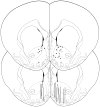Disparity between tonic and phasic ethanol-induced dopamine increases in the nucleus accumbens of rats
- PMID: 19389195
- PMCID: PMC2947861
- DOI: 10.1111/j.1530-0277.2009.00942.x
Disparity between tonic and phasic ethanol-induced dopamine increases in the nucleus accumbens of rats
Abstract
Background: Dopamine concentrations in the nucleus accumbens fluctuate on phasic (subsecond) and tonic (over minutes) timescales in awake rats. Acute ethanol increases tonic concentrations of dopamine, but its effect on subsecond dopamine transients has not been fully explored.
Methods: We measured tonic and phasic dopamine fluctuations in the nucleus accumbens of rats in response to ethanol (within-subject cumulative dosing, 0.125 to 2 g/kg, i.v.).
Results: Microdialysis samples yielded significant tonic increases in dopamine concentrations at 1 to 2 g/kg ethanol in each rat, while repeated saline infusions had no effect. When monitored with fast scan cyclic voltammetry, ethanol increased the frequency of dopamine transients in 6 of 16 recording sites, in contrast to the uniform effect of ethanol as measured with microdialysis. In the remaining 10 recording sites that were unresponsive to ethanol, dopamine transients either decreased in frequency or were unaffected by cumulative ethanol infusions, patterns also observed during repeated saline infusions. The responsiveness of particular recording sites to ethanol was not correlated with either core versus shell placement of the electrodes or the basal rate of dopamine transients. Importantly, the phasic response pattern to a single dose of ethanol at a particular site was qualitatively reproduced when a second dose of ethanol was administered, suggesting that the variable between-site effects reflected specific pharmacology at that recording site.
Conclusions: These data demonstrate that the relatively uniform dopamine concentrations obtained with microdialysis can mask a dramatic heterogeneity of phasic dopamine release within the accumbens.
Figures





References
-
- Boileau I, Assaad JM, Pihl RO, Benkelfat C, Leyton M, Diksic M, Tremblay RE, Dagher A. Alcohol promotes dopamine release in the human nucleus accumbens. Synapse. 2003;49:226–231. - PubMed
-
- Brodie MS, Shefner SA, Dunwiddie TV. Ethanol increases the firing rate of dopamine neurons of the rat ventral tegmental area in vitro. Brain Res. 1990;508:65–69. - PubMed
-
- Carelli RM, Wightman RM. Functional microcircuitry in the accumbens underlying drug addiction: insights from real-time signaling during behavior. Curr Opinion Neurobio. 2004;14:763–768. - PubMed
Publication types
MeSH terms
Substances
Grants and funding
LinkOut - more resources
Full Text Sources

